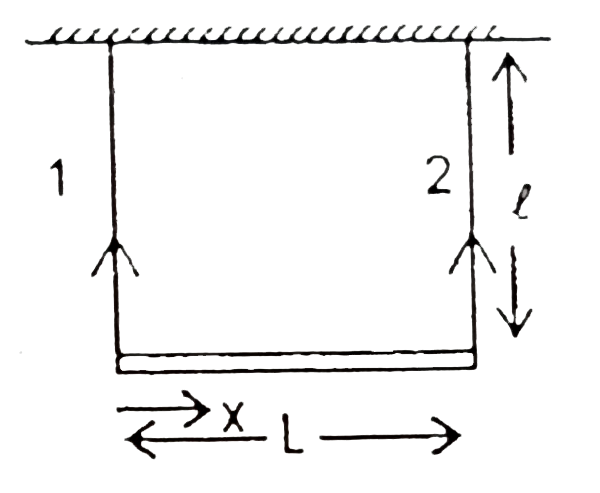Each of the two strings of length 51.6 cm and 49.1 cm are tensed separately by 20 N force. Mass per unit length of both the strings is same and equal to 1 g/m. When both the strings vibrate simultaneously the number of beats is ......Solution in Gujrati
7
8
3
5
The correct Answer is:A
Here frequency of vibration of string is,
f=12L√Tμ
∴f1=12(0.516)√200.001=144Hz
∴ Beat frequency f2−f1=144−137=7Hz
Topper's Solved these Questions
- BOOK - KUMAR PRAKASHANCHAPTER - WAVESEXERCISE - SECTION-F (Questions From Module) (Sample questions for preparation of competitive exams)23videos
WAVES
- BOOK - KUMAR PRAKASHANCHAPTER - WAVESEXERCISE - SECTION-D (NCERT Exemplar Solution) (Long Answer Type Questions)5videos
WAVES
- BOOK - KUMAR PRAKASHANCHAPTER - UNITS AND MEASUREMENTEXERCISE - Section -F (Questions from Module )20videos
UNITS AND MEASUREMENT
- BOOK - KUMAR PRAKASHANCHAPTER - WORK, ENERGY AND POWER EXERCISE - QUESTION PAPER (SECTION - D)1videos
WORK, ENERGY AND POWER
Similar Questions
In a standing wave formed by two atoms separated by 1.21Å, there are 3 nodes and 2 antinodes. Find its wavelength.
01:31View SolutionThe earth has a radius of 6400 km. The inner core of 1000 km radius is solid. Outside it, there is a region from 1000 km to a radius of 3500 km which is in molten state. Then again from 3500 km to 6400 km the earth is solid. Only longitudinal (P) waves can travel inside a liquid. Assume that the P wave has a speed of 8 kms−1 in solid parts and of 5kms−1 in liquid parts of the earth. An earthquake occurs at some place close to the surface of the earth. Calculate the time after which it will be recorded in a seismometer at a diametrically opposite point on the earth if wave travels along diameter ?
01:31View SolutionIf the error in measurement of radius of a shpere is 2% then the error in determination of volume of the sphere will be …………
View SolutionA 1 kg block situated on a rough incline is connected to a spring constant 100Nm−1 as shown in figure . The block is released from rest with the spring in the unstretched position . The block moves 10 cm down the incline before coming to rest . Find the coefficient of friction between the block and the incline .Assume that the spring has a negligible mass and the pulley is frictionless.
 03:51View Solution
03:51View SolutionEach of the strings of length 51.6 cm and 49.1 cm are tensioned separately by 20 N force. Mass per unit length of both the strings is the same and equal to 1gm^(-1) . When both the strings vibrate simultaneoulsy the number of beats is
02:45View SolutionEach of the two strings of length 51.6 cm and 49.1 cm are tensioned separately by 20 N force. Mass per unit length of both the strings is same and equal to 1 g//m . When both the strings vibrate simultaneously, the number of beats is
02:52View SolutionTwo strings of the same length but different mass per unit length are used to suspend a rod whose density varies as ρ=ρ0[1+αx] as shown in the figure. The frequency of standing waves produced in the string is in the ratio n:1, when both the strings are vibrating in their fundamental mode. If the mass per unit length of string (l) is μ0, calculate the mass per unit length of the other string.
 01:31View Solution
01:31View SolutionA string of length 1m and mass 5g is fixed at both ends. The tension in the string is 12.5 N. The string is set into vibration using an external vibrator of frequency 100 Hz. The separation between successive nodes on the string (in m) is ______ .
04:01View SolutionA 20 cm long string, having a mass of 1.0 g, is fixed at both the ends. The tension in the string is 0.5 N. The string is set into vibrations using an external vibrator of frequency 100 Hz. Find the separation (in cm) between the successive nodes on the string.
04:08View SolutionA string of mass per unit length "0.2 kg m"^(-1) and length 0.6 m is fixed at both ends such that it has a tension of 80 N. If the string is vibrating in its second overtone mode, then the frequency of the string is
04:56View SolutionEach of the two strings of length 51.6cm and 49.1cm are tensioned separately by 20N force. Mass per unit length of both the strings is same and equal to 1g/m. When both the strings vibrate simultaneously, the number of beats is
03:29View SolutionA 20 cm long string, having a mass of 1 . 0 g is fixed at both the ends. The tension in the string is 0 . 5 N . The string is set into vibration using an external vibrator of frequency 10 Hz . Find the separation (in cm) between the successive nodes on the string .
02:36View Solutionलम्बाई 51.6 सेमी तथा 49.1 सेमी की दो रेडियों पर अलग-अलग 20 न्यूटन बल का तनाव लगाया जाता है| दोनों डोरियों के प्रति एकांक लम्बाई का द्रव्यमान समान तथा 1 ग्राम मी−1 है| जब दोनों डोरियों साथ-साथ कम्पन करती है, तब विस्पंदों की संख्या है
02:47View SolutionEach of the two strings of length 51.6 cm and 49.1 cm are tensioned separately by 20 N force. Mass per unit length of both the strings is same and equal to 1 g/m. When both the strings vibrate simultaneously the number of beats is :
02:47View SolutionEach of the two strings of length 51.6 cm and 49.1 cm are tensioned separately by 20 N force. Mass per unit length of both the strings is same and equal to 1 g//m . When both the strings vibrate simultaneously, the number of beats is
04:54View Solution

